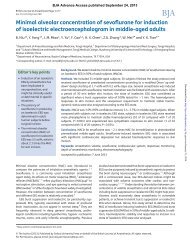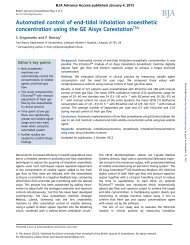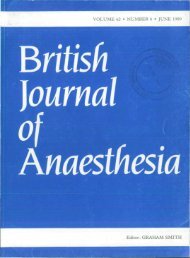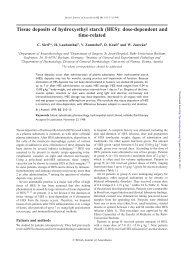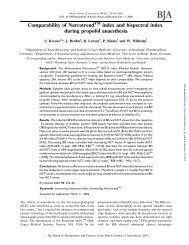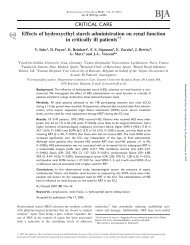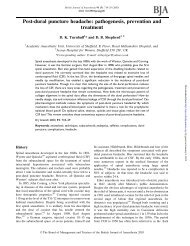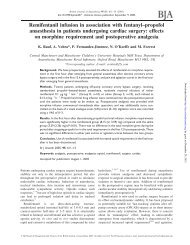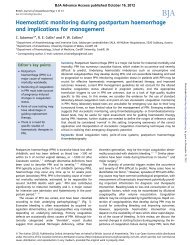CASE REPORTS Aspiration and the laryngeal mask airway ... - BJA
CASE REPORTS Aspiration and the laryngeal mask airway ... - BJA
CASE REPORTS Aspiration and the laryngeal mask airway ... - BJA
You also want an ePaper? Increase the reach of your titles
YUMPU automatically turns print PDFs into web optimized ePapers that Google loves.
British Journal of Anaes<strong>the</strong>sia 93 (4): 579–82 (2004)<br />
doi:10.1093/bja/aeh228 Advance Access publication July 9, 2004<br />
<strong>CASE</strong> <strong>REPORTS</strong><br />
<strong>Aspiration</strong> <strong>and</strong> <strong>the</strong> <strong>laryngeal</strong> <strong>mask</strong> <strong>airway</strong>: three cases <strong>and</strong><br />
a review of <strong>the</strong> literature {<br />
C. Keller 1 , J. Brimacombe 2 *, J. Bittersohl 3 , P. Lirk 1 <strong>and</strong> A. von Goedecke 1<br />
1 Department of Anaes<strong>the</strong>sia <strong>and</strong> Intensive Care Medicine, Leopold-Franzens University, Innsbruck, Austria.<br />
2 James Cook University, Department of Anaes<strong>the</strong>sia <strong>and</strong> Intensive Care, Cairns Base Hospital, Australia.<br />
3 Department of Anaes<strong>the</strong>siology <strong>and</strong> Intensive Care Medicine, Philipps-University, Marburg, Germany<br />
*Corresponding author. E-mail: jbrimaco@bigpond.net.au<br />
The primary limitation of <strong>the</strong> <strong>laryngeal</strong> <strong>mask</strong> <strong>airway</strong> (LMAÒ ) z<br />
is that it does not reliably protect <strong>the</strong><br />
lungs from regurgitated stomach content. We describe three cases of aspiration associated with <strong>the</strong><br />
LMA, including <strong>the</strong> first brain injury, <strong>the</strong> first death, <strong>and</strong> <strong>the</strong> first associated with <strong>the</strong> intubating LMA,<br />
<strong>and</strong> review <strong>the</strong> 20 specific case reports of aspiration associated with <strong>the</strong> LMA that we were able to<br />
find described in <strong>the</strong> literature.<br />
Br J Anaesth 2004; 93: 579–82<br />
Keywords: complications, aspiration pneumonitis; complications, mortality; equipment, <strong>mask</strong>s,<br />
<strong>laryngeal</strong> <strong>mask</strong> <strong>airway</strong><br />
Accepted for publication: May 25, 2004<br />
Pulmonary aspiration of gastric contents accounts for 5% of<br />
respiratory claims against <strong>the</strong> anaes<strong>the</strong>siologist. 1 The primary<br />
limitation of <strong>the</strong> <strong>laryngeal</strong> <strong>mask</strong> <strong>airway</strong> (LMA) is that it<br />
does not reliably protect <strong>the</strong> lungs from regurgitated stomach<br />
contents, although it may act as a barrier at <strong>the</strong> level of <strong>the</strong><br />
upper oesophageal sphincter if it is correctly positioned. 2 The<br />
incidence of aspiration with <strong>the</strong> LMA has been estimated at<br />
0.02%, 3 which is similar to tracheal intubation in elective<br />
patients. 4 We describe three cases of aspiration associated<br />
with <strong>the</strong> LMA, including <strong>the</strong> first brain injury, <strong>the</strong> first death,<br />
<strong>and</strong> <strong>the</strong> first associated with <strong>the</strong> intubating LMA, <strong>and</strong> review<br />
<strong>the</strong> literature.<br />
Case report 1<br />
A 49-yr-old female (ASA Physical Status III, BMI 16 kg m 2 )<br />
with low-grade sepsis presented for incision <strong>and</strong> drainage of a<br />
vaginal abscess. She had a past medical history of gastric<br />
surgery for carcinoma <strong>and</strong> multiple intra-abdominal procedures,<br />
but had no symptoms of reflux. On examination she<br />
was Mallampati grade 1. The <strong>airway</strong> management plan was to<br />
use a classic LMA; tracheal intubation was not considered<br />
necessary as <strong>the</strong> patient was fasted <strong>and</strong> had no reflux; <strong>and</strong> <strong>the</strong><br />
ProSeal LMA was unavailable. Induction was with fentanyl<br />
100 mg <strong>and</strong> propofol 120 mg. Maintenance was with propofol<br />
6mgkg 1 h 1 in oxygen 30% <strong>and</strong> air. No neuromuscular<br />
blocking agent was given. A size 4 classic LMA was easily<br />
inserted by a second year resident at <strong>the</strong> first attempt using <strong>the</strong><br />
st<strong>and</strong>ard recommended technique <strong>and</strong> <strong>the</strong> cuff inflated with<br />
20-ml air. Pressure controlled ventilation was commenced<br />
<strong>and</strong> tidal volumes of 450 ml were easily achieved with peak<br />
<strong>airway</strong> pressures of 15 cm H2O. The LMA <strong>and</strong> bite block was<br />
fixed according to <strong>the</strong> manufacturer’s instructions 5 <strong>and</strong> <strong>the</strong><br />
patient placed in <strong>the</strong> lithotomy position. At <strong>the</strong> start of <strong>the</strong><br />
procedure, <strong>the</strong> patient suddenly started vomiting, which was<br />
attributed to inadequate anaes<strong>the</strong>tic depth, <strong>and</strong> bile-stained<br />
fluid was seen in <strong>the</strong> <strong>airway</strong> tube. The surgeon was asked to<br />
stop, <strong>the</strong> patient was given oxygen 100%, anaes<strong>the</strong>sia was<br />
deepened, head down tilt applied, <strong>and</strong> a neuromuscular blocking<br />
agent administered. A suction ca<strong>the</strong>ter was passed to <strong>the</strong><br />
end of <strong>the</strong> <strong>airway</strong> tube <strong>and</strong> around 40 ml of bile-stained fluid<br />
removed. Ventilation <strong>and</strong> gas exchange was unaffected.<br />
Fibre-optic inspection down <strong>the</strong> <strong>airway</strong> tube revealed bilestained<br />
fluid within <strong>the</strong> trachea. The LMA was removed <strong>and</strong><br />
<strong>the</strong> patient easily intubated. The procedure was completed<br />
uneventfully. There were no postoperative complications.<br />
Case report 2<br />
A 73-yr-old female (ASA Physical Status III, BMI 35 kg m 2 )<br />
presented for bilateral varicose vein surgery, to be done in <strong>the</strong><br />
{ This article is accompanied by Editoral II.<br />
z LMA Ò is <strong>the</strong> property of Intavent Ltd.<br />
# The Board of Management <strong>and</strong> Trustees of <strong>the</strong> British Journal of Anaes<strong>the</strong>sia 2004<br />
Downloaded from<br />
http://bja.oxfordjournals.org/ by guest on March 28, 2013
supine position. She had a past medical history of adult onset 100%. Fibre-optic inspection revealed bile-stained fluid<br />
diabetes mellitus, chronic obstructive pulmonary disease, within <strong>the</strong> trachea. The procedure was completed <strong>and</strong> <strong>the</strong><br />
<strong>and</strong> gastric surgery for cancer. On examination she was patient transferred to ICU. The patient developed adult<br />
Mallampati grade 3. The <strong>airway</strong> management plan was to respiratory distress syndrome, renal failure, disseminated<br />
use a classic LMA; tracheal intubation was not considered intravascular coagulation <strong>and</strong> septicaemia, <strong>and</strong> died 85 days<br />
necessary. The anaes<strong>the</strong>tist was not aware of <strong>the</strong> past medical<br />
history, nor of her symptoms of daily reflux, <strong>and</strong> a ProSeal<br />
LMA was unavailable. Induction was with fentanyl 150 mg<br />
later from multi-organ failure.<br />
<strong>and</strong> propofol 180 mg. Maintenance was with oxygen 30% in<br />
nitrous oxide <strong>and</strong> sevoflurane 1.5%. Muscle relaxation was<br />
with atracurium 20 mg. A size 4 classic LMA was inserted<br />
easily by a highly experienced consultant at <strong>the</strong> first attempt<br />
using <strong>the</strong> st<strong>and</strong>ard recommended technique <strong>and</strong> <strong>the</strong> cuff<br />
inflated to <strong>and</strong> held constant at 60 cm H2O using a digital<br />
manometer. Volume controlled ventilation was commenced<br />
with tidal volumes of 600 ml <strong>and</strong> peak <strong>airway</strong> pressures of 18<br />
cm H2O. The LMA <strong>and</strong> bite block was fixed according to <strong>the</strong><br />
manufacturer’s instructions. In <strong>the</strong> middle of <strong>the</strong> procedure,<br />
bile-stained fluid was seen pouring out of <strong>the</strong> <strong>airway</strong> tube into<br />
<strong>the</strong> bacterial filter. The surgeon was asked to stop; <strong>the</strong> patient<br />
was given oxygen 100% <strong>and</strong> head down tilt applied. Ventilation<br />
was possible with <strong>the</strong> LMA, but gas exchange was poor<br />
with Spo2 less than 90% when <strong>the</strong> Fio2 was 1. The LMA was<br />
removed <strong>and</strong> <strong>the</strong> patient easily intubated, but <strong>the</strong>re was no<br />
improvement in gas exchange. Fibre-optic inspection showed<br />
bile-stained fluid in <strong>the</strong> trachea. The procedure was stopped<br />
<strong>and</strong> <strong>the</strong> patient transferred to ICU. On day 3, <strong>the</strong> patient<br />
developed severe adult respiratory distress syndrome<br />
(Fio2 1.0: Paa2 58 mm Hg). She was discharged from <strong>the</strong><br />
ICU after 56 days with a complete left-sided hemiplegia<br />
from a cerebral infarct.<br />
Literature review<br />
We conducted a Medline search for ‘Laryngeal <strong>mask</strong>’, read<br />
all <strong>the</strong> resultant publications <strong>and</strong> analysed all <strong>the</strong> reports<br />
where case-specific details were given. We found a total of<br />
20 specifically described case reports of aspiration of gastric<br />
content associated with <strong>the</strong> LMA (Table 1). Of <strong>the</strong> 20 cases of<br />
aspiration associated with <strong>the</strong> LMA, 14 were in adults 6–18 <strong>and</strong><br />
six in children, 19–24 6–17 19–24<br />
19 were with <strong>the</strong> classic LMA<br />
<strong>and</strong> one was with <strong>the</strong> ProSeal LMA. 18 In 14 cases, <strong>the</strong>re were<br />
factors that could increase <strong>the</strong> risk of aspiration, including, in<br />
orderoffrequency,inadequatedepthofanaes<strong>the</strong>sia, 913192123<br />
intra-abdominal surgery, 7 10 18 upper gastrointestinal disease,<br />
9 11 lithotomy position, 11 20 7 20<br />
patient movement,<br />
exchanging <strong>the</strong> LMA for a tracheal tube, 12 16 full stomach, 22<br />
multiple trauma, 6 multiple insertion attempts, 14 opioids, 6<br />
obesity, 10 <strong>and</strong> cuff deflation. 7 There is only one report<br />
where aspiration occurred where <strong>the</strong> patient had no risk factors.<br />
24 In addition, Kluger <strong>and</strong> Short, 25 in a review of 133<br />
cases of aspiration reported to <strong>the</strong> Australian Anaes<strong>the</strong>tic<br />
Incident Monitoring Study, documented 27 cases of aspiration<br />
associated with <strong>the</strong> LMA. However, <strong>the</strong> data from<br />
<strong>the</strong>se patients were not separated from aspiration associated<br />
with a tracheal tube (n=8), Hudson <strong>mask</strong> (n=5), <strong>and</strong><br />
face<strong>mask</strong> (n=91).<br />
Case report 3<br />
A 78-yr-old female (ASA Physical Status II, BMI 32 kg m 2 )<br />
presented for a total hip replacement. She had a past medical<br />
history of labile hypertension <strong>and</strong> a hiatus hernia, but had no<br />
symptoms of reflux. On examination she was Mallampati<br />
grade 2. The <strong>airway</strong> management plan was to intubate <strong>the</strong><br />
patient via <strong>the</strong> intubating LMA ra<strong>the</strong>r than using direct<br />
laryngoscopy to attenuate <strong>the</strong> haemodynamic stress response.<br />
Tracheal intubation was considered necessary as <strong>the</strong> procedure<br />
was prolonged <strong>and</strong> <strong>the</strong> ProSeal LMA was unavailable.<br />
Induction was with methohexitone 80 mg. Maintenance was<br />
with isoflurane 0.7% <strong>and</strong> nitrous oxide in oxygen 30%. Muscle<br />
relaxation was with rocuronium 50 mg. A size 4 intubating<br />
LMA was inserted easily by a second year resident at <strong>the</strong> first<br />
attempt <strong>and</strong> <strong>the</strong> cuff inflated with 30-ml air. Manual ventilation<br />
was commenced with tidal volumes of 500 ml <strong>and</strong> peak<br />
<strong>airway</strong> pressures of 17 cm H2O. Before intubation through <strong>the</strong><br />
intubating LMA was started, bile-stained fluid was seen in <strong>the</strong><br />
mouth. The patient was given oxygen 100%, but head down<br />
tilt was not applied. Ventilation was possible with <strong>the</strong> LMA.<br />
The intubating LMA was removed <strong>and</strong> <strong>the</strong> patient intubated<br />
using a laryngoscope. Ventilation was adequate <strong>and</strong> gas<br />
exchange acceptable with a Pao2 of 206 mm Hg on oxygen<br />
Keller et al.<br />
580<br />
Discussion<br />
All three patients in our series were at increased risk of aspiration:<br />
<strong>the</strong> first had gastric surgery <strong>and</strong> low-grade sepsis; <strong>the</strong><br />
second had gastric surgery <strong>and</strong> diabetes; <strong>and</strong> <strong>the</strong> third had a<br />
hiatus hernia. Both patients with adverse outcomes were<br />
elderly, ASA grade III, or both. Although this is <strong>the</strong> first report<br />
of brain injury <strong>and</strong> death from aspiration associated with <strong>the</strong><br />
LMA, it is likely that <strong>the</strong>re have been o<strong>the</strong>r such events. Given<br />
that <strong>the</strong> LMA has been used in 150 million patients since its<br />
release in 1988 (www.lmaco.com), a frequency of 0.02% for<br />
aspiration 3 <strong>and</strong> a mortality rate for aspiration of 5% (based on<br />
data from <strong>the</strong> pre-LMA era 4 ), <strong>the</strong>re should have been around<br />
1500 deaths. Perhaps patients with <strong>the</strong> LMA have a lower<br />
mortality rate, as <strong>the</strong> LMA tends to be used in healthy patients<br />
undergoing minor procedures. Perhaps <strong>the</strong> lack of reporting is<br />
related to medico-legal considerations, or journals decline<br />
such reports, as it is already established that aspiration can<br />
occur with <strong>the</strong> LMA <strong>and</strong> that aspiration can cause death.<br />
An assessment of aspiration risk is critical to determining<br />
whe<strong>the</strong>r <strong>the</strong> LMA should be used <strong>and</strong>, to a lesser extent, which<br />
type of LMA should be used, as <strong>the</strong> correctly placed ProSeal<br />
Downloaded from<br />
http://bja.oxfordjournals.org/ by guest on March 28, 2013
Table 1. Cases of pulmonary aspiration of gastric contents. *P=placement phase, M=maintenance phase, E=emergence phase. { GIT=gastrointestinal tract, TT=tracheal<br />
tube. z ICU=Intensive Care Unit, PPV=positive pressure ventilation, SpO 2 =oxygen saturation. # Approximate time of aspiration after induction. **ProSeal LMA.<br />
+ Intubating LMA<br />
Age Gender ASA Phase* Predisposing conditions {<br />
LMA can prevent aspiration. 26–28 The patient should be questioned<br />
about upper gastrointestinal disease, focusing on current<br />
symptoms <strong>and</strong> treatment. Unfortunately, <strong>the</strong>re are no<br />
data from which to make an evidence-based decision<br />
about whe<strong>the</strong>r or not symptoms are severe enough to warrant<br />
tracheal intubation. Most anaes<strong>the</strong>siologists consider that <strong>the</strong><br />
LMA is contraindicated in patients with gastroesophageal<br />
reflux, but a recent survey revealed that 57–73% of Australian<br />
anaes<strong>the</strong>siologists would use <strong>the</strong> LMA in patients with a<br />
history of reflux esophagitis or hiatus hernia provided it<br />
was asymptomatic. 29 Interestingly, one of our patients had<br />
an asymptomatic hiatus hernia. O<strong>the</strong>r factors affecting<br />
aspiration risk are fasting status, <strong>the</strong> use of gastroparetic<br />
drugs, <strong>the</strong> presence/severity of pain, <strong>the</strong> type/duration/<br />
position of surgery being performed, <strong>the</strong> depth of anaes<strong>the</strong>sia,<br />
<strong>and</strong> <strong>airway</strong> obstruction.<br />
All three patients in our series were intubated once a diagnosis<br />
of aspiration had been made, even though ventilation<br />
was possible with <strong>the</strong> LMA. We recommend that if pharyngeal<br />
regurgitation or pulmonary aspiration is suspected, <strong>the</strong><br />
patient should be placed in <strong>the</strong> head-down position, oxygen<br />
100% administered, anaes<strong>the</strong>sia deepened, suctioning performed<br />
<strong>and</strong> <strong>the</strong> severity of <strong>the</strong> regurgitation/aspiration event<br />
assessed fibre-optically. The decision about whe<strong>the</strong>r to<br />
<strong>Aspiration</strong> <strong>and</strong> <strong>the</strong> LMA<br />
Outcome z<br />
Adults<br />
Wilkinson et al. 6<br />
50 F M (1.5 h) #<br />
Multitrauma. Opioids<br />
Griffin <strong>and</strong> Hatcher 7<br />
26 F I E Movement. Cholecystectomy.<br />
Cuff deflation<br />
ICU 24 h. No PPV. Good recovery<br />
Koehli 8<br />
51 M II P ICU. PPV 20 h. Good recovery<br />
Nanji <strong>and</strong> Maltby 9<br />
74 M III M Dementia. Upper GIT disease.<br />
Inadequate anaes<strong>the</strong>tic depth<br />
ICU. PPV 4 days. Good recovery<br />
Brain 10<br />
M No sequelae<br />
Brain 10<br />
F P Obesity. Cholecystectomy No sequelae<br />
Brimacombe <strong>and</strong> Berry 11<br />
75 M III M Lithotomy. Dementia.<br />
Upper GIT disease<br />
ICU. PPV 1 week. Good recovery<br />
Langer et al. 12<br />
55 M II M LMA/TT exchange for<br />
bronchospasm<br />
Good recovery<br />
Hamada 13<br />
29 M I M Inadequate anaes<strong>the</strong>tic depth No PPV. Good recovery<br />
Miyasaka 14<br />
66 M II P Multiple insertion attempts Good recovery<br />
Verghese <strong>and</strong> Brimacombe 15<br />
68 F M ICU not required<br />
Vogelsang et al. 16<br />
77 F II M (2 h) #<br />
LMA/TT exchange for<br />
prone position<br />
Multi-organ failure. PPV 7 weeks<br />
Gaitini et al. 17 ** No details<br />
provided<br />
Brimacombe <strong>and</strong> Keller 18 ** 64 M I M (1 h) #<br />
Unidentified malposition.<br />
Cholecystectomy<br />
No PPV. Good recovery<br />
Current 49 F III M Gastric surgery. Septic.<br />
Lithotomy.<br />
No sequelae<br />
Current 73 F III M (0.5 h) Diabetes. Gastric surgery ICU 56 days. Stroke<br />
Current +<br />
Children<br />
78 F II P Upper GIT disease Multi-organ failure. ICU 85 days. Died<br />
Maroof et al. 19<br />
15 I–II M (2 h) #<br />
Inadequate anaes<strong>the</strong>tic depth ICU. No PPV. Rapid recovery<br />
Alex<strong>and</strong>er 20<br />
8 F II M Movement. Lithotomy position No PPV. Good recovery<br />
Braun <strong>and</strong> Fritz 21<br />
II Inadequate anaes<strong>the</strong>tic depth Good recovery<br />
Ismail-Zade <strong>and</strong> Vanner 22<br />
Lussmann <strong>and</strong> Gerber<br />
7 II M Not fully fasted Spo2 fell to 86%; briefly intubated<br />
23<br />
10 F I M Inadequate anaes<strong>the</strong>tic depth PPV for 4 days. Good recovery<br />
Cassinello 24<br />
0.8 M I M None Pneumonia. No PPV. Good recovery<br />
581<br />
intubate <strong>the</strong> trachea or continue with <strong>the</strong> LMA will depend<br />
on how well <strong>the</strong> LMA is functioning, <strong>the</strong> severity of <strong>the</strong><br />
regurgitation/aspiration event <strong>and</strong> <strong>the</strong> anticipated risk of<br />
fur<strong>the</strong>r regurgitation/aspiration. Removal of <strong>the</strong> LMA may<br />
result in fur<strong>the</strong>r regurgitation <strong>and</strong> consideration should be<br />
given to intubating <strong>the</strong> patient fibre-optically via <strong>the</strong> LMA.<br />
Consideration should also be given to passing a gastric tube,<br />
but this may also provoke fur<strong>the</strong>r regurgitation.<br />
In summary, we report <strong>the</strong> first cases of aspiration-related<br />
brain injury <strong>and</strong> death associated with <strong>the</strong> LMA, <strong>and</strong> <strong>the</strong> first<br />
case of aspiration associated with <strong>the</strong> intubating LMA. In<br />
principle, meticulous selection of patients <strong>and</strong> surgical procedures,<br />
optimal management of <strong>the</strong> placement, maintenance<br />
<strong>and</strong> emergence phases, <strong>and</strong> use of <strong>the</strong> ProSeal LMA can<br />
reduce <strong>the</strong> risk of aspiration.<br />
References<br />
1 Caplan RA, Posner KL, Ward RJ, Cheney FW. Adverse respiratory<br />
events in anes<strong>the</strong>sia: a closed claims analysis. Anes<strong>the</strong>siology 1990;<br />
72: 828–33<br />
2 Keller C, Brimacombe J, Raedler C, Puehringer F. Do <strong>laryngeal</strong><br />
<strong>mask</strong> <strong>airway</strong> devices attenuate liquid flow between <strong>the</strong> esophagus<br />
<strong>and</strong> pharynx? A r<strong>and</strong>omized, controlled cadaver study. Anesth Analg<br />
1999; 88: 904–7<br />
Downloaded from<br />
http://bja.oxfordjournals.org/ by guest on March 28, 2013
3 Brimacombe J, Berry A. The incidence of aspiration associated with<br />
<strong>the</strong> <strong>laryngeal</strong> <strong>mask</strong> <strong>airway</strong>—a meta-analysis of published literature.<br />
J Clin Anesth 1995; 7: 297–305<br />
4 Warner MA, Warner WE, Webber JG. Clinical significance of<br />
pulmonary aspiration during <strong>the</strong> perioperative period. Anes<strong>the</strong>siology<br />
1993; 78: 56–62<br />
5 Verghese C. LMA-Classic TM , LMA-Flexible TM , LMA-Unique TM .<br />
Instruction Manual. Henley-on-Thames: The Laryngeal Mask Company<br />
Ltd, 1999<br />
6 Wilkinson PA, Cyna AM, MacLeod DM, et al. The <strong>laryngeal</strong> <strong>mask</strong>:<br />
cautionary tales. Anaes<strong>the</strong>sia 1990; 45: 167–8<br />
7 Griffin RM, Hatcher IS. <strong>Aspiration</strong> pneumonia <strong>and</strong> <strong>the</strong> <strong>laryngeal</strong><br />
<strong>mask</strong> <strong>airway</strong>. Anaes<strong>the</strong>sia 1990; 45: 1039–40<br />
8 Koehli N. <strong>Aspiration</strong> <strong>and</strong> <strong>the</strong> <strong>laryngeal</strong> <strong>mask</strong> <strong>airway</strong>. Anaes<strong>the</strong>sia<br />
1991; 46: 419<br />
9 Nanji GM, Maltby JR. Vomiting <strong>and</strong> aspiration pneumonitis with <strong>the</strong><br />
<strong>laryngeal</strong> <strong>mask</strong> <strong>airway</strong>. Can J Anaesth 1992; 39: 69–70<br />
10 Brain AIJ. The <strong>laryngeal</strong> <strong>mask</strong> <strong>and</strong> <strong>the</strong> oesophagus. Anaes<strong>the</strong>sia<br />
1991; 46: 701–2<br />
11 Brimacombe J, Berry A. <strong>Aspiration</strong> <strong>and</strong> <strong>the</strong> <strong>laryngeal</strong> <strong>mask</strong><br />
<strong>airway</strong>—a survey of Australian intensive care units. Anaesth<br />
Intens Care 1992; 20: 534–5<br />
12 Langer A, Hempel V, Ahlhelm T, Heipertz W. [Experience with use<br />
of <strong>the</strong> <strong>laryngeal</strong> <strong>mask</strong> in over 1900 general anaes<strong>the</strong>tics]. Anaes<strong>the</strong>siologie<br />
Intensivmedizin Notfalmedizin Schmerz<strong>the</strong>rapie 1993; 28:<br />
156–60<br />
13 Hamada I. [Vomiting <strong>and</strong> pulmonary aspiration during <strong>the</strong> use of <strong>the</strong><br />
LM]. J Clin Anesth 1991; 15: 1219–20<br />
14 Miyasaka C. A case of pulmonary aspiration during insertion of LM.<br />
J Clin Anesth 1991; 15: 1360<br />
15 Verghese C, Brimacombe J. Survey of <strong>laryngeal</strong> <strong>mask</strong> <strong>airway</strong> usage<br />
in 11910 patients: safety <strong>and</strong> efficacy for conventional <strong>and</strong> nonconventional<br />
usage. Anesth Analg 1996; 82: 129–33<br />
16 Vogelsang H, Uhlig T, Schmucker P. [Severe multiorgan<br />
failure caused by aspiration with <strong>laryngeal</strong> <strong>mask</strong> <strong>airway</strong>].<br />
Anas<strong>the</strong>siol Intensivmed Notfallmed Schmerz<strong>the</strong>r 2001; 36: 63–5<br />
17 Gaitini LA, Vaida SJ, Somri M, Ben-David B, Hagberg CA. A r<strong>and</strong>omized<br />
controlled trial comparing <strong>the</strong> Proseal <strong>laryngeal</strong> <strong>mask</strong><br />
David <strong>and</strong> Heinrichs<br />
British Journal of Anaes<strong>the</strong>sia 93 (4): 582–6 (2004)<br />
doi:10.1093/bja/aeh231 Advance Access publication July 26, 2004<br />
<strong>airway</strong> with <strong>the</strong> Sonda Laryngeal Tube in Mechanically Ventilated<br />
Patients. Anes<strong>the</strong>siology 2002; 96: A1319 (Abstract)<br />
18 Brimacombe J, Keller C. <strong>Aspiration</strong> of gastric contents during use<br />
of a ProSeal <strong>laryngeal</strong> <strong>mask</strong> <strong>airway</strong> secondary to unidentified<br />
foldover malposition. Anesth Analg 2003; 97: 1192–4<br />
19 Maroof M, Khan RM, Siddique MS. Intraoperative aspiration<br />
pneumonitis <strong>and</strong> <strong>the</strong> <strong>laryngeal</strong> <strong>mask</strong> <strong>airway</strong>. Anesth Analg 1993;<br />
77: 409–10<br />
20 Alex<strong>and</strong>er R, Arrowsmith JE, Frossard RJ. The <strong>laryngeal</strong><br />
<strong>mask</strong> <strong>airway</strong>: safe in <strong>the</strong> X ray department. Anaes<strong>the</strong>sia 1993;<br />
48: 734<br />
21 Braun U, Fritz U. [The <strong>laryngeal</strong> <strong>mask</strong> in pediatric anes<strong>the</strong>sia.]<br />
Anaes<strong>the</strong>siologie Intensivmedizin Notfalmedizin Schmerz<strong>the</strong>rapie<br />
1994; 29: 286–8<br />
22 Ismail-Zade IA, Vanner RG. Regurgitation <strong>and</strong> aspiration of gastric<br />
contents in a child during general anaes<strong>the</strong>sia using <strong>the</strong> <strong>laryngeal</strong><br />
<strong>mask</strong> <strong>airway</strong>. Paed Anaesth 1996; 6: 325–8<br />
23 Lussmann RF, Gerber HR. [Severe aspiration pneumonia with <strong>the</strong><br />
<strong>laryngeal</strong> <strong>mask</strong>.] Anaes<strong>the</strong>siologie Intensivmedizin Notfalmedizin<br />
Schmerz<strong>the</strong>rapie 1997; 32: 194–6<br />
24 Cassinello F, Rodrigo FJ, Munoz-Alameda L, et al. Postoperative<br />
pulmonary aspiration of gastric contents in an infant after general<br />
anes<strong>the</strong>sia with <strong>laryngeal</strong> <strong>mask</strong> <strong>airway</strong> (LMA). Anesth Analg 2000;<br />
90: 1457.<br />
25 Kluger MT, Short TG. <strong>Aspiration</strong> during anaes<strong>the</strong>sia: a review of<br />
133 cases from <strong>the</strong> Australian Anaes<strong>the</strong>tic Incident Monitoring<br />
Study (AIMS). Anaes<strong>the</strong>sia 1999; 54: 19–26<br />
26 Keller C, Brimacombe J, Kleinsasser A, Loeckinger A. Does <strong>the</strong><br />
ProSeal <strong>laryngeal</strong> <strong>mask</strong> <strong>airway</strong> prevent aspiration of regurgitated<br />
fluid? Anesth Analg 2000; 91: 1017–20<br />
27 Brimacombe J, Keller C. Airway Protection with <strong>the</strong> ProSeal<br />
Laryngeal Mask Airway: a case report. Anaesth Intens Care 2001;<br />
29: 288–91<br />
28 De Silva KK, Young P. Protection against aspiration with <strong>the</strong> Proseal<br />
<strong>laryngeal</strong> <strong>mask</strong> <strong>airway</strong>. Anaesth Intensive Care 2002; 30: 391<br />
29 Crilly H, McLeod K. Use of <strong>the</strong> <strong>laryngeal</strong> <strong>mask</strong> <strong>airway</strong>—a survey of<br />
Australian anaes<strong>the</strong>tic practice. Anaesth Intens Care 2000; 28; 224<br />
(Abstract)<br />
High-frequency oscillatory ventilation <strong>and</strong> an interventional<br />
lung assist device to treat hypoxaemia <strong>and</strong> hypercapnia<br />
M. David* <strong>and</strong> W. Heinrichs<br />
Department of Anaes<strong>the</strong>siology, Johannes Gutenberg-University, Mainz, Germany<br />
*Corresponding author. E-mail: david@mail.uni-mainz.de<br />
A male patient accidentally aspirated paraffin oil when performing as a fire-eater. Severe acute<br />
respiratory distress syndrome (Pa O2 /FI O2 ratio 10.7 kPa) developed within 24 h. Conventional<br />
pressure-controlled ventilation (PCV) with high <strong>airway</strong> pressures <strong>and</strong> low tidal volumes failed<br />
to improve oxygenation. Hypercapnia (Pa CO2 12 kPa) with severe acidosis (pH



